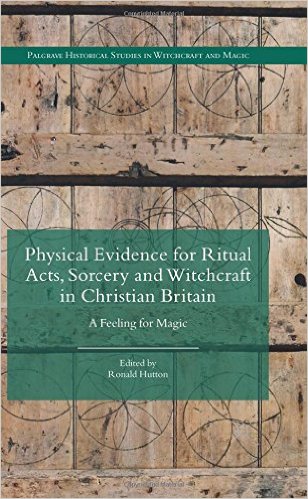Review: Physical Evidence, A Feeling for Magic May 2, 2016
Author: Beach Combing | in : Contemporary, Medieval, Modern , trackback
Ronald Hutton (ed), Physical Evidence for Ritual Acts, Sorcery and Witchcraft in Christian Britain: A Feeling for Magic (Palgrave Macmillan 2016)
Academic essay collections fall into different categories including such old and tried favourites as: ‘new directions’; ‘pot pouri’; ‘the EU gave us some money so we had a conference’; and ‘x is wrong and we are right’. However, Physical Evidence is in a category all of its own because it essentially founds a new discipline: the archaeology of modern British and Irish magic. Now, of course, there are, from time to time, academic books that create new spaces for study. But they are, most easily, the work of a single scholar. Here, instead, Ronald Hutton, has corralled eleven writers into putting down everything that they know about such unusual topics as cats and shoes hidden in walls, witch bottles, stone heads, and magic marks in churches. Some of this material has been covered before. For example, stone heads had been written about by John Billingsley in a 1993 masters thesis and again in a short and little known 1998 book, Stony Gaze. But in these pages such ruminations can reach a wider audience and, perhaps for the first time, be taken seriously by an academic community that is all too often chary about hokus pokus. Diarmaid MacCullough happily appears on the back cover giving his recommendation.
In historical terms the most exciting thing about this material is its invisibility in our written sources. For example, it is clear that there was, across the English-speaking world, and perhaps much further (the lack of a continental dimension in Physical Evidence is sometimes frustrating), the custom of closing a cat in a wall space during building works: many, many of these cats have been discovered and some are posed, ruling out the possibility of accidents in all cases. Yet there is no mention of cat sacrifice in writing prior to the Victorian period. We have, in other words, the unusual experience of ‘prehistoric’ customs in a well documented epoch. The same is true of many of the other ritual acts described here, including the geometric shapes and letters etched onto the walls of buildings. The only written parallel that Timothy Easton has been able to come up with for this is a record relating to early twentieth-century East Anglia about men scratching symbols in the dust to protect cattle! Even when we do have written sources they seem to bear only a passing relation to the physical remains: e.g. magical amulets. Then why do dead cats turn up in Australia whereas witch bottles are absent: yet both appear in America. Chronology presumably?
So how do you study something about which no one has ever written, where every bit of information has to be recovered from the walls of private homes or from forgotten archives? The most interesting essay in this respect is June Swann’s, who records, her sixty-year-long odyssey to understand the many shoes she has come across, stowed in walls or hearths; particularly children’s shoes. She started by assuming that children had placed shoes in these ‘dangerous places’ (118) and wondered whether they did not get in trouble with their parents. Then, through conversations with other collectors, she realized that these were deliberate deposits. Next came a card index; remember those? Then, in 1969, she wrote an article on these mysterious shoes, getting no feedback from bewildered peers, and in 2016, we have this more complete chapter. Does June have any answers? Not really, though there is, thanks mainly to her, a great deal of data and no one reading this chapter could possibly doubt that she has identified a real custom. Two pairs of shoes bricked into a hearth can be explained but twenty, two hundred, two thousand… Are we, though, understanding them correctly? Will our time capsules be interpreted in the twenty-ninth century as an inarticulate work of sorcery? What about the lines on the wall where we record our children’s height: growing magic, names etched and re-etched into the woodwork?
One of the pleasing aspects of Physical Evidence is the deference of the present to older magics. There are frequent examples of house owners insisting on keeping their ritual finds: putting them back in the space they found them; though some rogues sold a magic bottle on ebay. Others display their finds but then leave them with new owners: the objects belong, like Brownie, to the house; any one who has lived in a old building will know that feeling of being grafted onto another reality. Then, there is the updating. So we have a Buddha head being stuck into a house front, in imitation, perhaps, of the tradition of stone heads on buildings. We have modern ‘witches’ making their own witch bottles with ‘menses’: despite the fact that witch bottles were supposed to be the death of witches. There are also moments of high emotion. The servant who dropped a new born and presumably ‘forbidden’ baby down a space in a house wall. (Imagine the smell and the horror that followed: ‘Must be a dead rat, Miss.’) The modern lab tech opening a witch bottle and examining the nail clippings and urine of someone who died two hundred years before. Then what about the most exciting magical finds of recent years, passed over quickly in the introduction, Saveock Water and Barway, where we might possibly glimpse more dramatic spells dissolving in English soil.
To be recommended in the highest possible terms!
Beach is always on the lookout for unusual book: Drbeachcombing At yahoo DOT com


